What is pulmonary artery stenosis?
The pulmonary arteries are the two major vessels that carry blood from the heart to the lungs. The right branch takes blood to the right lung, the left branch to the left lung.
Pulmonary artery stenosis is a narrowing of any part of these blood vessels. Stenosis means narrowing.
Pulmonary artery stenosis means that not enough blood flows to the lungs. The narrowed area needs to be expanded so that more blood can flow through it.
What is a balloon angioplasty?
A balloon angioplasty is a procedure to dilate (open up) the narrow blood vessel and increase blood flow. The procedure is done in the cardiac (heart) catheterization laboratory.

What is heart catheterization?
During heart catheterization, the doctor carefully puts a long, thin tube called a catheter into a vein or artery in your child's neck or groin. The groin is the area at the top of the leg. Then, the catheter is threaded through the vein or artery to your child's heart.
The doctor who does the procedure is a cardiologist, which means a doctor who works on the heart and blood vessels. This may not be your child's regular cardiologist.
There are small risks of complications from the procedures
Generally, heart catheterization is a low-risk procedure, but it is not risk-free. The doctor will explain the risks to you in more detail before you give your consent for the procedure. The most common risks are as follows:
The catheter may break through a blood vessel
There is a very small risk that the catheter may break through a blood vessel or the heart wall. To reduce this risk, we use a type of X-ray called fluoroscopy to see where the catheters are at all times.
Your child may develop a tear in the artery wall
The artery wall may tear, causing bleeding into the chest. This is rare. But if it does happen, your child may need surgery to repair the tear.
What happens during the procedure
Your child will be given a special "sleep medicine" called a general anaesthetic. This means your child will be asleep during the procedure.
During the catheterization, the doctor threads a special catheter through your child's blood vessels to the narrowed area. The team takes X-ray pictures and measurements of the coarctation. Then the team threads a deflated balloon on the tip of the catheter to the area of the coarctation. The balloon is then inflated to open up the narrowed area. Sometimes a second larger balloon is used to dilate the area further.
Sometimes the doctor may choose to put in a stent. A stent is a small metal tube made of stainless steel or another type of metal. The stent helps widen the narrowed passage by supporting the walls of the blood vessel to keep it open.
After the coarctation is opened up, the team takes a second set of pictures and measurements. The doctor then takes out the balloons and catheters and covers the cuts on your child's legs with a bandage.
The procedure usually takes two to four hours
The procedure usually takes two to four hours. After the procedure, your child will go to the recovery room for about two hours to wake up from the anaesthetic.
After the procedure
The cardiologist will let you know when your child can go home. Your child will stay in the hospital for at least four to six hours after the procedure. Some children can go home on the same day as the procedure, but some children will need to stay in the hospital overnight. If your child needs to stay overnight, they will be transferred to the inpatient unit.
Coming back for a check-up
Your child will be given a date and time to see your cardiologist two to three months after the procedure. At this appointment, a pulmonary perfusion scan is often done. This scan shows the amount of blood flow to the right and left lungs.
Write the date and time of the appointment here:
Antibiotics to prevent infectious endocarditis
Depending on your child's specific heart condition, your child may need to take antibiotics before and after some dental and other procedures. These drugs help prevent a heart infection called infectious endocarditis. Speak to your cardiologist for more information.